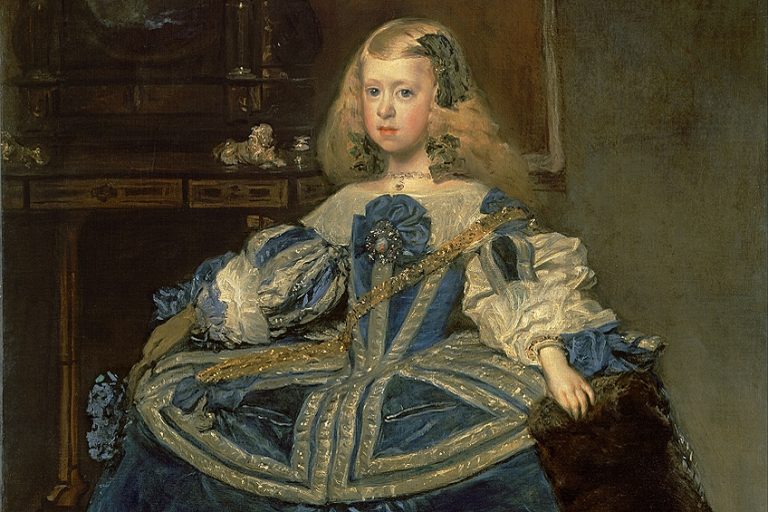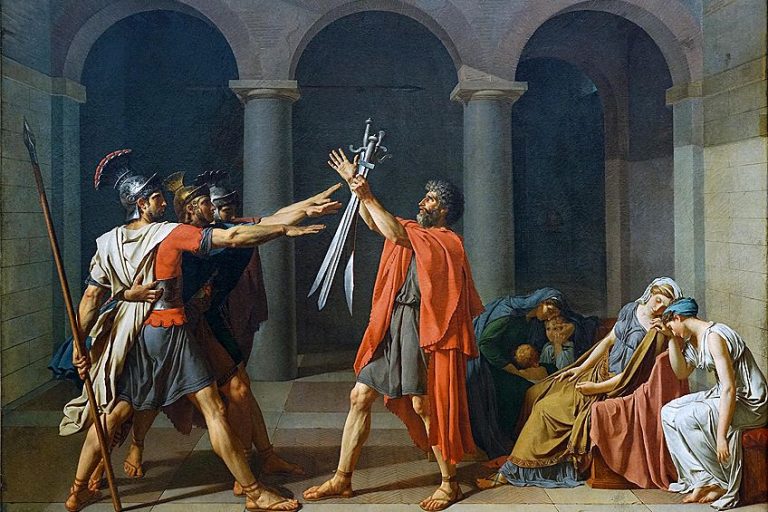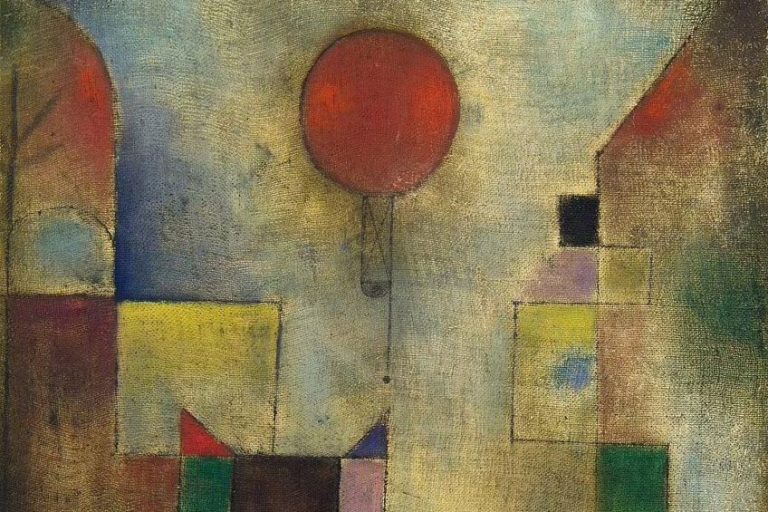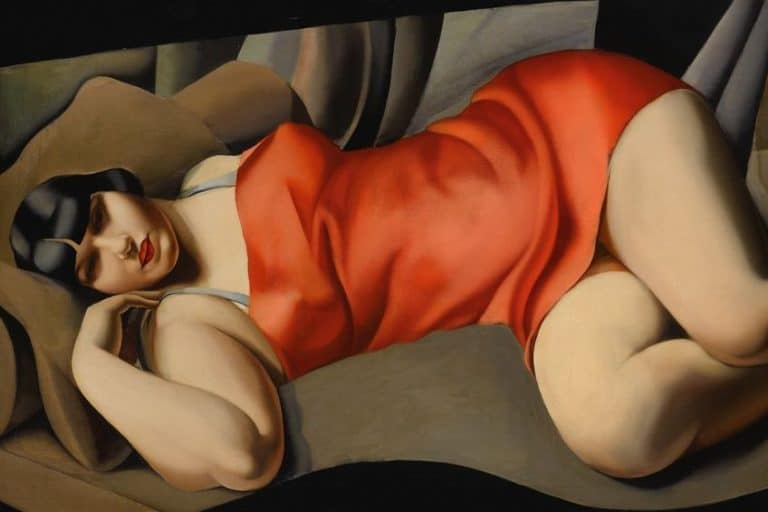“The Source” by Jean-Auguste-Dominique Ingres – A Classic Nude
The Source, a masterpiece by Jean-Auguste-Dominique Ingres, epitomizes the Neoclassical style that flourished in the early 19th century. Created between 1820 and 1856, this exquisite painting depicts a nude young woman gracefully holding a pitcher of water, symbolizing purity and the eternal source of life. Ingres’ meticulous attention to anatomical detail, coupled with his ability to convey the delicate interplay of light and shadow, showcases his profound mastery of form and composition. The Source stands as a testament to Ingres’ dedication to classical ideals and his influential role in shaping the course of Western art history.
Key Takeaways
- The Source was completed in 1856 by Jean-Auguste-Dominique Ingres.
- The painting is displayed in the Musée d’Orsay in Paris.
- It showcases idealized beauty and Ingres’s mastery of the human form.
Historical Context
| Artist | Jean-Auguste-Dominique Ingres (1780 – 1867) |
|---|---|
| Date Created | 1856 |
| Medium | Oil on canvas |
| Genre | Neoclassical |
| Period/Movement | Neoclassicism |
| Dimensions (cm) | 163 × 80 |
| Series/Versions | Single version |
| Where Is It Housed? | Musée d’Orsay, Paris, France |
| What It Is Worth | Not publicly auctioned; extremely high cultural and historical value |
Jean-Auguste-Dominique Ingres’s painting, The Source, stands as a marvel of Neoclassical art. The piece, finished in 1856 after more than three decades of work, depicts a nude woman holding an urn from which water flows. This artwork is housed in the Musée d’Orsay in Paris, a testament to its significance and the esteem in which it is held. The painting’s creation began in Florence around 1820, and it shows Ingres’s skill in portraying the human form.

The female figure is both a symbol and an example of idealized beauty. The background elements, though simpler, enhance the main subject, directing all attention to the focal point. Ingres was 76 years old when he completed The Source, and it marked a high point in his career. As president of the École des Beaux-Arts, his influence was already considerable, and this painting solidified his legacy. Its display in prominent museums highlights its cultural and artistic impact.
Ingres’s Neoclassical Influence
Ingres was deeply rooted in Neoclassicism. He believed in adhering to the classical traditions set by predecessors like Jacques-Louis David. These traditions emphasized line, form, and clarity. Ingres’s focus on the female nude and his meticulous technique underscores his allegiance to these principles. Ingres aimed to uphold academic orthodoxy against the Romantic style of his contemporaries, such as Eugène Delacroix. Delacroix emphasized emotion and color contrast, which starkly contrasted Ingres’s approach.
Ingres’s presidency at the École des Beaux-Arts in Paris further cemented his role as a guardian of these classical traditions.
Comparative Works
The Source is an oil-on-canvas masterpiece, begun in 1820 and finished in 1856. It encapsulates Ingres’s lifelong commitment to classical art forms. When comparing Ingres’s work to others, it’s essential to consider pieces like Delacroix’s paintings, which focus on dynamic movement and vibrant color. Ingres’s focus on stillness and composure is evident in The Source, especially next to The Source by Gustave Courbet, who painted in response to Ingres. Courbet’s version diverges by presenting a less idealized vision of the human form.

This contrast highlights the stylistic tensions between Neoclassicism and the emerging Romantic and Realist movements during this period. An oil on canvas technique used in The Source and its historical setting in Paris reflect European influences on French Neoclassical painters, further illustrating the period’s rich artistic landscape.
Artistic Details of The Source
The Source by Jean-Auguste-Dominique Ingres is a masterpiece that showcases the artist’s attention to detail and mastery of Neoclassical techniques. This painting features a nude figure symbolizing purity and the life-giving power of water.
Subject Matter
The painting features a nude woman, central to the composition. This figure represents purity and nature, likening the woman to a source of water. Ingres’s work mirrors famous depictions of deities such as the Greek Aphrodite of Cnidus and Roman Venus Pudica.
These classical influences emphasize the connection between the female form and natural elements.
Use of Color, Line, and Texture
Ingres utilizes a soft color palette to create a serene atmosphere. The skin of the figure is rendered in smooth, pale tones. This contrasts with the darker background, making her the focal point. His lines are precise and delicate, defining contours without overwhelming texture. The jar from which water flows is depicted with meticulous detail, enhancing the realism of the scene.

Composition and Technique
Ingres’s composition is balanced and symmetrical. The vertical alignment of the figure emphasizes her importance. The surrounding elements, like the ceramic jar and flowering plants, complement without distracting from the central figure. Techniques such as chiaroscuro and meticulous brushwork showcase Ingres’s craftsmanship.
His focus on the female form involved the assistance of his studio, but the execution bears his signature precision.
Symbolism and Themes
Symbolism runs deep in The Source. The flowing water from the jar signifies life and purity, resonating with the symbolic unity of woman and nature. The fertile imagery of blooming plants enhances this theme. The portrayal of the nude merges classical themes of beauty and purity with the Romantic idea of poetic inspiration. This connection to nature likens the figure to muses, evoking the timeless connection between the divine and the natural world.

Cultural and Artistic Impact
The Source has left a substantial mark on the art world. Its exhibitions and changing ownership have influenced how it is perceived, while its legacy and relevance have endured through centuries, continuing to impact art, culture, and discussions around feminine beauty and vulnerability.
Exhibitions and Ownership
When finished in 1856, The Source was immediately recognized as a masterpiece. Initially exhibited in the Paris Salon, the painting captured the attention of the art community. Over time, it has been displayed in several notable institutions. It currently resides at the Musée d’Orsay in Paris. Ownership of the painting has passed through various hands, reflecting its high value and significance in the art world.
Its various exhibitions have continually renewed public interest and scholarly attention, keeping it alive in cultural memory.
Legacy and Relevance
Ingres’ depiction of the female nude in The Source has had lasting impacts on views of feminine beauty and artistic vulnerability. The pose and idealized form of the nude can be traced back to classical traditions, yet it also introduces themes of water and regeneration, further symbolizing purity and natural beauty. The painting’s influence extends beyond art into literature and cultural studies.

Its continuing relevance underscores debates on the morality of artistic production, examining how art reflects societal values regarding femininity and beauty. Additionally, The Source is often seen as a symbol of order and disorder, combining classical elegance with natural realism, thus resonating across different periods and artistic movements. This blend of classical and modern themes ensures the painting’s lasting importance in art history.
Critical Reception and Interpretation
The Source has been examined and critiqued by various art historians and critics since its completion. It has garnered significant attention both at the time of its unveiling and in contemporary art circles.
Contemporary Reviews
When The Source was unveiled in 1856, it received mixed reviews. At that time, the prominence of neoclassical aesthetics was noted. Frances Fowle and Richard Thomson highlight how Jean-Auguste-Dominique Ingres was praised for his masterful technique. His detailed and smooth portrayal of the female nude was seen as a triumph of the neoclassical style. Haldane MacFall, a notable art critic, praised Ingres’ exceptional attention to anatomical precision and the elegant simplicity of the composition.
The Musée du Louvre, where the painting is housed today, became a hub for artists and students who studied this major work. This reception solidified Ingres’ status as a leading artist of his time.
Modern Analysis
Modern critics and historians have revisited The Source with fresh perspectives. Scholars like Kenneth Clark and Walter Friedländer have offered interpretations that connect the work to broader themes of morality and artistic production in the 19th century.
George Moore, a critic, notes that the painting embodies purity and natural beauty, reflecting societal ideals of the period. Both Frances Fowle and Richard Thomson emphasize the meticulous craftsmanship and symbolic depth present in the work. This painting not only depicts physical beauty but also explores deeper symbolic meanings, making it a rich subject for contemporary analysis.
Jean-Auguste-Dominique Ingres’ The Source remains a timeless representation of Neoclassical aesthetics and artistic skill. Through his meticulous rendering of form, the evocative use of light, and the symbolic richness of the subject matter, Ingres elevates this painting to a pinnacle of artistic achievement. The Source not only embodies the ideals of purity and beauty but also reflects Ingres’ profound understanding of classical art principles. Its enduring appeal and significance in art history reaffirm Ingres’ legacy as a masterful painter whose work continues to inspire and captivate audiences worldwide.
Frequently Asked Questions
What Is the Significance of The Source by Jean-Auguste-Dominique Ingres?
The Source is an important work by Ingres. It was completed in 1856 when he was seventy-six. This painting features a nude female figure holding a pitcher, symbolizing purity and the origin of life. It combines classical art themes with romantic execution.
How Does The Source by Ingres Reflect Neoclassicism?
The Source embodies Neoclassicism through its idealized human form and balanced composition. Ingres focused on precise lines and smooth surfaces, evoking the ancient Greek and Roman statuary. The painting emphasizes harmony, proportion, and calmness, hallmarks of Neoclassical art.
What Techniques Are Prominent in The Source by Ingres?
Ingres utilized fine brushwork to create smooth skin textures. He paid great attention to line and form, ensuring clarity and precision. The background was less detailed to emphasize the main figure, which demonstrates his prioritization of the subject over the setting.
How Does The Source Compare With Grande Odalisque in Ingres’ Oeuvre?
The Source and Grande Odalisque both showcase Ingres’ skill in portraying the human body. While The Source emphasizes purity and classical beauty, Grande Odalisque is more exotic and sensual. Both paintings feature elongated forms and smooth, clear lines, typical of Ingres’ style.
Isabella studied at the University of Cape Town in South Africa and graduated with a Bachelor of Arts majoring in English Literature & Language and Psychology. Throughout her undergraduate years, she took Art History as an additional subject and absolutely loved it. Building on from her art history knowledge that began in high school, art has always been a particular area of fascination for her. From learning about artworks previously unknown to her, or sharpening her existing understanding of specific works, the ability to continue learning within this interesting sphere excites her greatly.
Her focal points of interest in art history encompass profiling specific artists and art movements, as it is these areas where she is able to really dig deep into the rich narrative of the art world. Additionally, she particularly enjoys exploring the different artistic styles of the 20th century, as well as the important impact that female artists have had on the development of art history.
Learn more about Isabella Meyer and the Art in Context Team.
Cite this Article
Isabella, Meyer, ““The Source” by Jean-Auguste-Dominique Ingres – A Classic Nude.” Art in Context. June 19, 2024. URL: https://artincontext.org/the-source-by-jean-auguste-dominique-ingres/
Meyer, I. (2024, 19 June). “The Source” by Jean-Auguste-Dominique Ingres – A Classic Nude. Art in Context. https://artincontext.org/the-source-by-jean-auguste-dominique-ingres/
Meyer, Isabella. ““The Source” by Jean-Auguste-Dominique Ingres – A Classic Nude.” Art in Context, June 19, 2024. https://artincontext.org/the-source-by-jean-auguste-dominique-ingres/.











